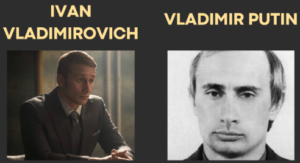Russians in Movies: Why are they always the bad guys?
Introduction
Poorly known and subject to a wide range of diffuse stereotypes, Russia has always been at the centre of a deceptive, exaggerated and misleading representation, which contributed to the Western collective idea that Russians are always the bad guys… or at least in movies are always depicted like this!
Characters in a narrative text, like those in a film, form the fundamental element for the development of the story. The main character and his antagonist are those who give personality to the whole story, mark the time of the plot and shape the viewer’s perception.
It is therefore easy to understand the importance of roles in a story, but the cinema has a power that is so often underestimated.
It is able to shape from scratch or completely overturn the viewer’s idea of things. Cinema has often been used as a weapon of conditioning rather than as a source of truth, and being that cinematography is a very powerful medium it would be proper to use it as a truth-teller… But then why are Russians always portrayed as the villains in movies?
Why are Russians the bad guys?
It is very likely that you remember Ivan Drago’s quote “I must break you”. If you don’t, please go and watch this movie. We are talking about an epic scene of Rocky IV, in which the “fighter from the Soviet Union”, Drago, fights against the American hero Rocky Balboa, threatening him with this sentence. We all know (or at least can imagine) how it is going to end.
This is just one of the many cinematographic examples of Russians depicted as villains. This (mis)representation has a long history: the portrayal of Russia in Western popular culture has served various purposes, particularly between 1945 and 1991. With a few exceptions, Soviet citizens, have been characterized as cunning enemies in Western popular culture.
This kind of stereotyping was evident even before the Cold War as Russia is historically a threat to the West, but it has increased during the Cold War because of Soviet communism. After the fall of the Berlin Wall, the interest in Russian villains faded a little bit in favour of Muslims and Chinese, but after the Russiagate there has been an incessant barrage of anti-Russian films and TV.
Some hints to be a true (stereotyped) Russian evil
First of all, Russians are represented with caricatured and terrible accents. What about their names? They are always the same: Dimitry, Vladimir, Ivan, Boris… I swear that there are other Russian names. Men are usually short, with slicked-back hair and flashy gold chains, while women are very tall and sexy, and if the “villain” is a woman, they are usually spies. Last but not least, Russia is always depicted with a blue and grey filter, even if the reality is very different. And you don’t know how, but it is always winter.

Here some cinematographic examples of this stereotyped representation
Stranger Things (2016–)
One of the most famous TV series of the last years is Stranger Things, a show that takes place in the fictional town of Hawkins in Indiana in the mid-80s. The third and fourth seasons perfectly depict the previous stereotypes. It is no coincidence that Hopper is reduced to captivity in a Soviet secret base, as Stranger Things is set in the same period when it seemed in Hollywood that bad guys had to come from Moscow: the years are exactly the same as those of the US-USSR crisis. Obviously, Americans are kind of one-trick-pony when it comes to Russian names: Dmitri, Yuri, Alexei… Never heard of them!
James Bond – Octopussy (1983)
General Orlov seems unstoppable. In this incredible movie of the James Bond saga, James has to come to terms with a lunatic Russian who lives to realise his dream: a nuclear explosion in Europe. Orlov is completely insane, and his goal, namely the nuclear devastation of Europe, would allow a Soviet ground invasion. Again, crazy evil Russians.
Red Sparrow (2018)
If you take a look at this movie’s reviews, you will find a list of clichés that reflect the political situation of those years, dominated by US citizens’ anger for the loss of their favoured presidential candidate, for which they blame the Kremlin. Dominika is a prima ballerina who becomes a spy after a career-ending injury to provide for her ill mother. First cliché: the only “power” of this spy seems to be her body, which is always shown as if her only strength is to be constantly objectified.
The second stereotype is about depicting horrifying Russian behaviours as if it was commonplace: people are treated like property, men are unethical and morally corrupt, even sadistic, women are constantly assaulted, everyone is communist, and places are depressing and gloomy. The cherry on the pie is that Dominika is initially approached by her uncle Ivan from the SVR… What does he look like? Look at a photo of a young Vladimir Putin, and you tell me.
Conclusion
This antagonism between Americans and Russians in western films is embedded to the point that it risks becoming a real obstacle to dialogue and mutual understanding.
Enemies are bad; we are good, or at least better than them. Moreover, the enemy fits well into the role of scapegoat. They are the guilty ones for almost everything that goes wrong… and it is always easier to represent things this way instead of analyzing the psychology of the parties.
Especially in times of difficult political and diplomatic relations such as the current ones, which are strongly characterized by the aftermath of the crisis in Ukraine, it seems more necessary than ever to educate in the deconstruction of stereotypes and a new attitude of openness.
We want to give a very special thanks to Enrica Aquilano, Sofia Borra, Benedetta Breda and Veronica Riello, students of the Dipartimento di Management, Master in Business Administration in Università degli Studi di Torino, for sharing their project and give us the possibility to publish it.





